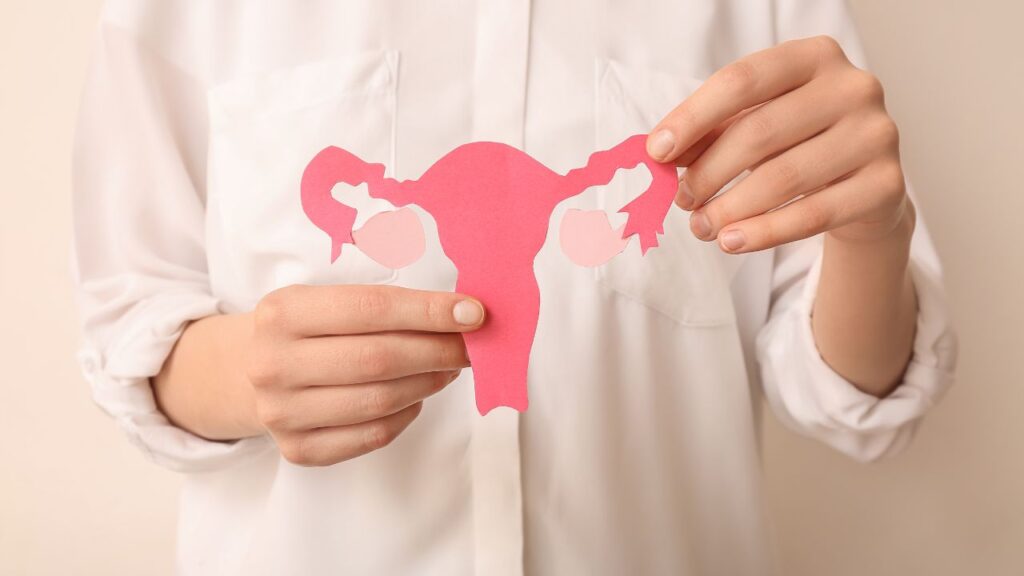“Why Is My Hair Falling Out?” The Perimenopause Hair Loss Survival Guide

You’re brushing your hair, and—yikes—more strands are coming out than usual. Sound familiar? Hair loss during perimenopause is a frustrating but incredibly common experience. Here’s the good news: you’re not stuck with it forever. Once you understand why it’s happening, there’s a lot you can do to stop the shedding and even regrow what you’ve lost. Let’s break it down so you can get your confidence (and your hair) back.
Hormones Are to Blame (Of Course!)
Perimenopause is like puberty’s annoying twin—it flips your hormones upside down. The hormonal shifts during this time aren’t just inconvenient—they can also cause surprising changes, like hair thinning. Let’s break down how these hormonal troublemakers wreak havoc on your locks in a way that’s easy to understand.

Here’s how the usual suspects mess with your mane:
- Progesterone: Your Hair’s Chill Pill Is Missing. Progesterone is like a built-in anti-stress hormone for your body—and your hair loves it. It keeps things calm, reduces inflammation, and helps your hair grow strong and steady. But during perimenopause, progesterone levels start to dip. Without it, inflammation in your body can creep up, making your hair follicles less efficient at producing strong, healthy strands. What’s worse, these hormonal shifts can lead to heavier, shorter menstrual cycles, adding even more stress to the mix. The result? Hair that feels thinner and looks less full.
- Estrogen: The “Queen Bee” of Hair Health Says Goodbye. Estrogen is another hormone your hair relies on, especially for density and volume. This hormone keeps your hair lush, thick, and growing steadily, particularly around areas like your temples. But as you approach menopause, estrogen levels begin to drop. When this happens, your hair follicles don’t get the support they need, and you may notice your once-thick hairline looking a little sparse. It’s not that your hair vanishes overnight—it just grows thinner and slower, giving the illusion of hair loss.
- Cortisol: Stress is Literally Stealing Your Hair. We all know stress can mess with your mood, sleep, and overall well-being, but did you know it can mess with your hair, too? When you’re stressed, your body produces more cortisol, the so-called “stress hormone.” Think of cortisol as your body’s emergency alarm system—it’s great for short-term situations, but when it stays elevated for too long, it throws your entire hormonal balance off. High cortisol levels can push your hair into a “resting” phase, where it stops growing and starts shedding. Over time, this leads to noticeable thinning and more strands clogging your shower drain.
Types of Hair Loss to Watch For

Hair loss isn’t one-size-fits-all, and during perimenopause, it can show up in different ways. Understanding the specific type of hair loss you’re dealing with is the key to finding the right solution. Here’s a simple guide to the most common culprits.
- Androgen Dominance: Your body naturally produces a hormone called DHT (short for dihydrotestosterone), which can affect your hair follicles. When there’s too much DHT, it causes your hair follicles to shrink. Smaller follicles mean weaker hair that grows thinner and falls out more easily. You might notice your part starting to widen or the hair on top of your head looking a bit sparse. This is called androgen dominance, and it’s a common type of hair loss during perimenopause. The good news? Treatments like certain medications or hair regrowth products can help block DHT and give your follicles a fighting chance.
- Hormonal Hair Thinning: As your estrogen and progesterone levels drop during perimenopause, one of the first places you might notice thinning is at your temples. These hormones are like the foundation of healthy hair growth, and without them, your hair can start to look less full or even patchy in specific areas. This type of thinning doesn’t necessarily mean you’re losing large amounts of hair—it just grows back finer and less densely than before. Paying attention to these changes early can help you take steps to strengthen your strands before the thinning becomes more noticeable.
- Thyroid Drama: Your thyroid gland might be small, but it has a big job regulating your body’s metabolism and hormone balance. During perimenopause, your thyroid can sometimes go rogue—either becoming underactive (hypothyroidism) or overactive (hyperthyroidism). Both scenarios can lead to noticeable hair loss, often showing up as more strands in your brush or a thinner appearance overall. If you have a thyroid condition like Hashimoto’s disease (an autoimmune disorder affecting the thyroid), the hair loss can be even more dramatic. If you suspect your thyroid might be the issue, a quick blood test with your doctor can confirm it, and treatments are available to get things back on track.
- Nutritional Deficiencies: If your body isn’t getting the nutrients it needs, your hair is often one of the first places to show it. Low levels of iron, zinc, and B vitamins can make your hair brittle, weak, and prone to breakage. Without enough iron, for example, your hair follicles can’t get the oxygen they need to grow strong strands. Zinc and B vitamins are also essential for maintaining healthy hair texture and strength. The fix? A balanced diet rich in lean proteins, leafy greens, and whole grains—or supplements, if necessary—can make a big difference in the health and resilience of your hair.
Feed Your Hair: The Diet Connection

Want healthier hair? Start in the kitchen. Medical professionals’ advice is as simple as swapping junk food for nutrients that love your locks:
- Anti-Inflammatory Foods: Say no to gluten, sugar, dairy, and alcohol. Protect that gut and your hair will thank you.
- Protein Power: Eat 20-30 grams every 4 hours. Your hair is mostly protein—feed it!
- Iron Boosters: Load up on navy beans, black beans, red meat, and organ meats for strong strands.
- Omega-3 Fatty Acids: Keep dryness at bay with fish, flaxseeds, and walnuts.
- Vitamins & Minerals: B vitamins, zinc, and magnesium are your follicle’s best friends.
Herbal Helpers to the Rescue

Got a soft spot for natural remedies? These powerhouse herbs have been helping women grow gorgeous hair for centuries:
- Amla oil: Packed with Vitamin C to strengthen hair and prevent early graying.
- Dong Quai: This Chinese herb acts as a hormone-balancer for better scalp health.
- Fo-Ti: Known for improving hair quality and encouraging regrowth.
Stress Less for More Hair

Stress isn’t just bad for your brain—it’s a hair killer too. Here’s how to keep your calm and your strands:
- Acupuncture: Boosts blood flow and lowers cortisol.
- Craniosacral Therapy: Gentle and relaxing, it promotes circulation to the scalp.
- Sleep: Your hormones reset while you snooze. Aim for 7–9 hours of quality shut-eye.
When It’s Time to Call in the Pros
Sometimes, even your best efforts need backup. Advanced treatments can work wonders when natural fixes aren’t cutting it:
- Androgen Blockers: Medications like Spironolactone and Propecia can stop DHT in its tracks.
- Cutting-Edge Procedures: PRP therapy, microneedling, and red-light therapy stimulate regrowth.
- Hormone Replacement Therapy: Low-dose estrogen or progesterone might help balance your hormones—and your hairline.
The Big Picture
Hair loss during perimenopause can feel like a slap in the face, but it’s not the end of the world—or your good hair days. With a little patience and the right mix of diet, natural remedies, stress management, and advanced treatments, you can get your locks back on track. And along the way, you’ll learn that caring for your hair isn’t just about vanity—it’s about giving your whole body the care it deserves.
So let’s take this one strand at a time, and remember: you’ve got this!
